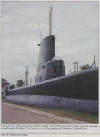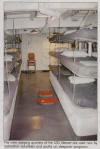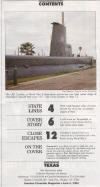Published
June 6, 2004
Houston Chronicle Texas Magazine
Galveston's 3-vessel tribute to a sub lost in World War II
By TOM BEHRENS
|
SEAWOLF
PARK
|
|
HOW TO GET THERE: Seawolf Park is about 50 miles south of
Houston. To reach it, drive to Galveston on Interstate 45, which becomes
Broadway in Galveston, and exit left onto 51st Street. Cross a bridge and
drive straight to the Pelican Island Causeway. This small road becomes
Seawolf Parkway, which leads to the park entrance.
Adults may tour both the Cavalla and the Stewart for $5; kids under 11 get in for $2. Parking is $5. Fishing-pier fees are $5 for adults and $2 for kids. Visitors 65 and older can fish for a year for $25. The park is open dawn to dusk Sundays-Thursdays. Fridays and Saturdays it's open 24 hours. For additional information, call 409-797-5114 or visit the park's Web site, www.cavalla.org. |
 Seawolf
Park on Pelican Island, just off Galveston Island proper, features a
three-story pavilion for watching oceangoing freighters, picnic sites, a
playground area and a lighted fishing pier.
Seawolf
Park on Pelican Island, just off Galveston Island proper, features a
three-story pavilion for watching oceangoing freighters, picnic sites, a
playground area and a lighted fishing pier.
All are good reasons to visit, but it's the combination of World War II submarine, nearby destroyer escort and a partially submerged concrete ship that accounts for many of the visitors to this memorial park on Galveston Bay.
Operated by the city of Galveston's parks department, Seawolf Park originated in 1971 as a memorial to the submarine Seawolf, lost in battle during World War II. A section of the park has since become a memorial to all submarines and submariners lost in the war.
Of the three vessels, the USS Cavalla, one of 16 remaining, nonoperating submarines left from World War II, is probably the park's most popular icon.
 Often
mistakenly referred to as the Seawolf, the Cavalla, like the Seawolf, is a
Gato-class fleet submarine. The Cavalla (pronounced kah-VAH-lah) is a
decorated battle veteran of the Pacific theater, earning a Presidential Unit
Citation on its maiden voyage for sinking the 30,000-ton aircraft carrier
Shokaku June 19, 1944.
Often
mistakenly referred to as the Seawolf, the Cavalla, like the Seawolf, is a
Gato-class fleet submarine. The Cavalla (pronounced kah-VAH-lah) is a
decorated battle veteran of the Pacific theater, earning a Presidential Unit
Citation on its maiden voyage for sinking the 30,000-ton aircraft carrier
Shokaku June 19, 1944.
The submarine also is credited with sinking a Japanese destroyer and three Japanese merchant ships.
Launched Nov. 14, 1943, the 306-foot-long Cavalla displaced 1,900 tons when submerged. Maximum diving depth was 300 feet. It could remain underwater for up to three days. After that it surfaced for six to 12 hours to replenish air and charge batteries. The crew consisted of 72 enlisted men and eight officers.
On Jan. 21, 1971, the Navy transferred possession of the Cavalla to the Texas submarine veterans of World War II. The sub was then delivered to its permanent berth in the new park.
 John
McMichael, the Cavalla's 60-year-old caretaker and historian, knows firsthand
what it was like to serve on a submarine. The retired Navy veteran spent 32
years serving on four diesel-electric and seven nuclear-powered submarines.
John
McMichael, the Cavalla's 60-year-old caretaker and historian, knows firsthand
what it was like to serve on a submarine. The retired Navy veteran spent 32
years serving on four diesel-electric and seven nuclear-powered submarines.
"I did not serve on the Cavalla," McMichael says, "but my first submarine was its sister ship, the Croaker."
He started his Navy submarine career as a machinist's mate, working on submarine hydraulics, compressed air and water systems. He achieved the rank of master chief petty officer.
"The submarine had a torpedo room in the front and (another in) the back end of the ship," says McMichael, beginning a tour through the narrow corridor of the Cavalla. "When the ship was built, there were six torpedo tubes up front. There are four now. In 1952 the Navy reconfigured the submarine from a fleet submarine to what was called an SSK, a submarine killer, a submarine designed to go out, find and `kill' other submarines.
"When they did that, they put a lot of sonar equipment right outside this bulkhead," he says, referring to the bulkhead in the forward torpedo room. "The top two torpedo tubes were in the way, so they were eliminated. (The sonar) gave the ship a lot more listening capability."
Sixteen torpedoes were lined up in the forward torpedo room, each 21 feet long, extending from the torpedo tube back to the bulkhead. Eight torpedoes were stored and ready to be loaded into the rear torpedo tubes.
The executive officer and senior officers slept in what was known as Officers Country.
"The captain had his own stateroom, and right across from the captain's stateroom was the executive officer's stateroom, where the executive officer and the next two senior officers under him slept."
 Sometime
in the past, renovation crews removed 40 bunk frames in the after battery,
which is one of the places where enlisted crew members slept, but they will be
reinstalled.
Sometime
in the past, renovation crews removed 40 bunk frames in the after battery,
which is one of the places where enlisted crew members slept, but they will be
reinstalled.
"People walk in here and see an open, big room and say, `Gee, you have all kinds of room in here.' I tell them to try to imagine it with 40 bunks in here. You can't imagine it with 40 bunks, so we are putting them all back up," McMichael says.
Additional bunks were spaced out through the ship, including the forward and rear torpedo rooms.
The vessel's office was where all the paperwork was done. "We have a lot of the original publications, but we are not putting them back in the office until we get the ship restored to the point where we have tour guides and we can keep an eye on things," McMichael says.
The dive alarm, general alarm and collision alarm all work. Pressure gauges line the walls amidships. "We have gauges down on this end for trim tanks and ballast tanks, to register pressure," McMichael says. "The big wheels, located adjacent to the conning tower, control the bow and stern planes that made the ship go up or down in the water. All of the controls that were operated hydraulically can be operated manually.
"Taking out the garbage was easy, even underwater," continued McMichael. Waste was disposed of through a tube in the side of the boat. "The bags were weighted with lead weights so that it would not float to the surface and tip off the location of the sub. This could be done while underwater. We could open a door on the outside, and all of this stuff would fall out into the ocean."
There were three toilets for 72 men. The officers shared a single toilet.
The Cavalla was equipped with four big diesel engines. The engines were not for direct propulsion but to drive a direct-current generator on the back of the engines. The generator provided electrical current to drive motors that turned the propeller. When the Cavalla was converted to a submarine killer in 1952, one of the diesels was removed to make way for a sonar room.
The Cavalla's interior temperature depended on its environment.
"If you took this submarine and put it in the Caribbean in the summertime, the average temperature throughout the ship would be 100 degrees," McMichael says. "In the engine rooms, if we were on the surface running the diesels, the temperature would be about 120-125 degrees. But then just the reverse is true: If we took this thing up around the North Pole in the wintertime, there would be ice on the bulkheads and the maze of piping throughout the ship. Very seldom would you reach a happy medium."
"We could submerge in 30 seconds," McMichael continues. "When you heard that diving alarm, everybody who was on watch had something to do, and you learned to do it now. They don't do that anymore. They do what they call controlled dives. ... You make preparations for diving."
 Permanently
berthed next to the Cavalla is the destroyer escort USS Stewart. The Stewart
was towed into the park in 1974, three years after the Cavalla arrived. The
Stewart's World War II résumé includes escorting 14 North Atlantic convoy
crossings between 1943 and 1946. In 1953 the ship was re-outfitted for the
Korean War, but fighting stopped before the Stewart could put to sea.
Permanently
berthed next to the Cavalla is the destroyer escort USS Stewart. The Stewart
was towed into the park in 1974, three years after the Cavalla arrived. The
Stewart's World War II résumé includes escorting 14 North Atlantic convoy
crossings between 1943 and 1946. In 1953 the ship was re-outfitted for the
Korean War, but fighting stopped before the Stewart could put to sea.
In 1974 the Navy decided to scrap it, but the Submarine Veterans of World War II heard about the upcoming fate of the destroyer escort and asked permission to have the ship towed to its present location at Seawolf Park.
Restoring ships is not cheap. Costs thus far for the Cavalla are almost $1 million. Some work on the Stewart is being postponed.
"We recently put an ad in the papers requesting funds to sandblast and paint the Stewart," McMichael says. "The most reasonable bid we have received is $600,000. We don't have the money to do that now, so we are looking at different alternatives."
All money for the renovations is received in the form of grants and donations. Volunteers do most of the work.
In the crew berthing area of the Stewart, "we started here and put 42 bunks back up," McMichael says. "They had previously been removed. In another section there are an additional 33 bunks. This is where our volunteers sleep. We also have a youth sleepover program for groups of 15 or more where kids can spend the night. We give them what we call a hard-hat tour of both ships in the spaces that aren't open to the public, give them a good history lesson of WWII and the naval battles fought. We show them a submarine-related movie, usually Operation Petticoat, a good family movie, and then they spend the night, either on the submarine or the destroyer escort, depending on the size of the group, or maybe on both."
 Wreckage
of a third ship lies just northwest of Seawolf Park's fishing pier, at the
entrance to the Galveston Ship Channel. It's the 421-foot concrete ship SS
Selma, one of 12 experimental concrete ships built by the U.S. Shipping Board
in 1917 and '18.
Wreckage
of a third ship lies just northwest of Seawolf Park's fishing pier, at the
entrance to the Galveston Ship Channel. It's the 421-foot concrete ship SS
Selma, one of 12 experimental concrete ships built by the U.S. Shipping Board
in 1917 and '18.
The Selma was built as a tanker with reciprocating steam engines and launched June 28, 1919. On May 11, 1920, the ship struck a jetty at Tampico, Mexico. The Selma was temporarily repaired and headed to Galveston for further repairs. But the repair crew in Galveston had no experience with concrete ships, and the government scrapped it. A channel was dug near Pelican Island, and on March 9, 1922, the Selma was taken to its final resting place.
Some of it remained above water, and legend has it that at one time a hermit occupied it for 10-12 years.
In 1992, the Selma was purchased by A. Pat Daniels, a retired Houston Chronicle copy editor and former reporter and city editor for the Galveston Daily News. Through his efforts, the Selma has been recognized with a Texas Historical Commission official Texas historical marker and is listed on the National Register of Historic Places. Every June 28 Daniels throws a birthday party for the Selma.
Tom Behrens is a Houston freelance writer.